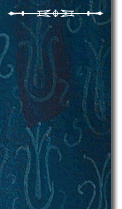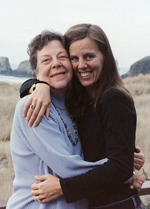


 |
 |
|
Feature :: Page 3 :: A Death of Her Choosing
Jump to Page 1 : 2 : >3< : 4 : 5 : 6 of A Death of Her Choosing
Early in 2000, Peggy Sutherland read a magazine article about improved CT scans and simply decided to have one. She had no symptoms, no problems. But the scan revealed more lung cancer—a different form, unrelated to what she’d had 14 years before. Another surgery was done, and several weeks later a follow-up scan was scheduled. McMurchie and Baltus were with her when the results came back—the CT showing cancerous hot spots like spiders’ nests throughout her lungs.
 |
| Julie Sutherland McMurchie '85 gives her mother, Peggy, a hug at the coast of Oregon, two months before Peggy's death. |
In April of that year, a third lung surgery was performed, more extensive than the first two. Although the surgeon again declared her cured, Sutherland didn’t recover quickly or well. It was during this time that one of her sisters was diagnosed with an advanced case of the same cancer. Over the summer, Sutherland watched her sister weaken and die: hospitalized for three months, at the end having no control over her bodily functions, and in great pain unrelieved by the morphine.
“It was a very grim experience, and it was clear my mom didn’t want that for herself—or us,” says Baltus. “She was very much into open communication about tough issues, and she began talking about assisted suicide even before her final diagnosis.”
Sutherland, far from cured, was diagnosed as terminal in August 2000. Through the late summer and fall she underwent different therapies and rounds of palliative care. As would be expected for a woman whose ex-husband, son, and one daughter were all physicians, she got the very best that medicine has to offer. And, as would be expected in a family with so much medical expertise, everyone was realistic about the fact that medicine couldn’t offer much.
“She made all of us sit down with her and talk about her estate and how she would take care of everything, how she wouldn’t be a burden,” McMurchie says. “I tried to get her to move in with me, but she would have none of that. She was feeling okay, still very much present in her life. She was religious about her Friday morning bridge game and going to the weekend house at the coast. For those last few months, she was fully alive.”
And then one day in the middle of December, Sutherland awoke and couldn’t get out of bed, could barely sit up. The pain was intense. She would never get out of bed again. An ambulance took her to the hospital, where she spent the next three weeks. A morphine pump was implanted in her body, but a dose of the drug large enough to kill the pain made her unconscious. Suffering or out cold—nothing in 21st-century health care offered a third choice, and to a woman like Sutherland this was not life.
McMurchie and Baltus remember spending a dark New Year’s Eve in the hospital with their mother and the rest of the family. In early January, Sutherland was sent home and hospice care was arranged. She had endured three major surgeries, three hospitalizations for pain, two rounds of chemotherapy and radiation, and countless CTs, MRIs, PETs, and bone scans. The day after she returned to her view of the river, Sutherland looked at her children and said quietly, “I’m done.”
![]()